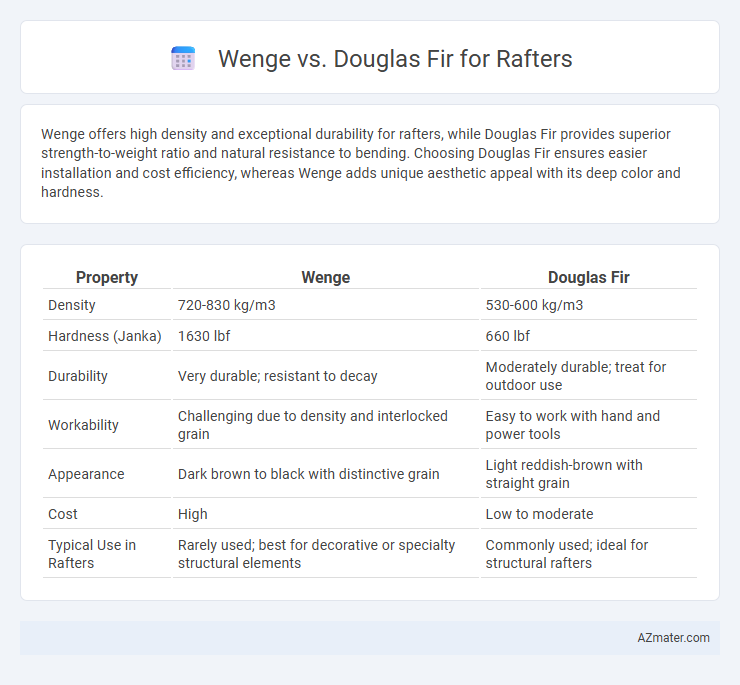Wenge offers high density and exceptional durability for rafters, while Douglas Fir provides superior strength-to-weight ratio and natural resistance to bending. Choosing Douglas Fir ensures easier installation and cost efficiency, whereas Wenge adds unique aesthetic appeal with its deep color and hardness.
Table of Comparison
| Property | Wenge | Douglas Fir |
|---|---|---|
| Density | 720-830 kg/m3 | 530-600 kg/m3 |
| Hardness (Janka) | 1630 lbf | 660 lbf |
| Durability | Very durable; resistant to decay | Moderately durable; treat for outdoor use |
| Workability | Challenging due to density and interlocked grain | Easy to work with hand and power tools |
| Appearance | Dark brown to black with distinctive grain | Light reddish-brown with straight grain |
| Cost | High | Low to moderate |
| Typical Use in Rafters | Rarely used; best for decorative or specialty structural elements | Commonly used; ideal for structural rafters |
Introduction to Wenge and Douglas Fir
Wenge is a dense, dark hardwood known for its rich chocolate color and exceptional durability, making it ideal for structural applications like rafters where strength is crucial. Douglas Fir is a softwood valued for its straight grain, moderate density, and excellent strength-to-weight ratio, commonly used in construction for rafters due to its stability and ease of workability. Both woods offer reliable performance in rafter construction, with Wenge providing superior hardness and visual appeal, while Douglas Fir is more widely available and cost-effective.
Origin and Availability
Wenge, a dense hardwood native to Central Africa, is prized for its deep, rich color and durability but is less commonly available outside specialty lumber markets. Douglas Fir, originating from the western United States and Canada, is widely accessible due to its fast growth and extensive commercial plantations. The abundant availability of Douglas Fir makes it a cost-effective and reliable choice for rafters, while Wenge's rarity and exotic origin often lead to higher prices and limited supply.
Appearance and Grain Patterns
Wenge rafters feature a rich, dark brown hue with subtle black streaks, showcasing a striking, dramatic appearance ideal for adding elegance and depth to architectural elements. Douglas Fir rafters display a lighter, warm reddish-brown color with prominent, straight grain patterns and occasional knots, contributing a rustic and natural aesthetic. The dense, interlocked grain of Wenge contrasts with the more uniform and tighter grain texture of Douglas Fir, influencing both visual appeal and finish options.
Strength and Durability Comparison
Wenge wood offers exceptional strength with a Janka hardness rating of approximately 1630, making it highly resistant to wear and impact, whereas Douglas Fir has a lower hardness of about 660 but is known for its excellent strength-to-weight ratio. In terms of durability, Wenge possesses natural resistance to decay and insect attacks, contributing to its long lifespan in structural applications, while Douglas Fir requires proper treatment to enhance its durability in outdoor or high-moisture environments. For rafters, Wenge provides superior load-bearing capacity and longevity but at a higher cost, while Douglas Fir remains a popular, cost-effective choice with reliable structural performance when adequately maintained.
Weight and Workability
Wenge wood is significantly denser and heavier than Douglas Fir, with a density of approximately 850 kg/m3 compared to Douglas Fir's 480 kg/m3, making it less suitable for applications requiring lightweight materials. Douglas Fir offers superior workability due to its softer texture, ease of cutting, and nailing, whereas Wenge's hardness and coarse grain make it more challenging to machine and shape. For rafters, the lighter weight and excellent workability of Douglas Fir provide practical advantages over the heavy and less workable Wenge.
Resistance to Decay and Insects
Wenge wood exhibits exceptional resistance to decay and insects due to its natural density and high concentration of tannins, making it highly durable for rafters in harsh environments. Douglas Fir, while moderately resistant to decay, is more prone to insect attack without proper treatment, requiring chemical preservatives for enhanced durability. Choosing Wenge for rafters ensures longer lifespan and reduced maintenance in decay-prone and insect-active conditions compared to untreated Douglas Fir.
Cost and Budget Considerations
Wenge offers a premium, dark hardwood option for rafters, typically costing significantly more than Douglas Fir, which is favored for its affordability and abundant availability. Budget-conscious projects often select Douglas Fir due to its lower price per board foot and excellent strength-to-weight ratio. When balancing durability and aesthetic value against cost, Douglas Fir provides a practical choice for cost-efficient rafters, whereas Wenge suits high-end applications with a higher budget.
Environmental Impact and Sustainability
Wenge wood, sourced primarily from Central Africa, is known for its dense grain and durability but raises environmental concerns due to overharvesting and slow growth rates, contributing to deforestation. Douglas Fir, widely available in North America, boasts a faster growth cycle and is often harvested from sustainably managed forests certified by organizations like FSC, making it a more eco-friendly option. Choosing Douglas Fir for rafters reduces carbon footprint and supports sustainable forestry practices compared to the more environmentally sensitive Wenge.
Best Applications for Rafters
Wenge wood offers exceptional strength and durability, making it ideal for rafters in heavy-load structures or high-end architectural projects requiring dark, rich coloration. Douglas Fir is favored for rafters in residential and commercial buildings due to its excellent dimensional stability, workability, and cost-effectiveness. Both woods provide solid structural integrity, but Douglas Fir is more commonly used in large-scale framing, while Wenge excels in premium applications where aesthetics and hardness are prioritized.
Final Verdict: Wenge vs Douglas Fir
Wenge rafters offer exceptional strength, durability, and a unique dark aesthetic, making them ideal for high-end architectural projects requiring a bold statement. Douglas Fir provides a cost-effective, lightweight alternative with excellent structural reliability and widespread availability, preferred in standard residential and commercial framing. Choosing between Wenge and Douglas Fir depends on budget considerations and desired appearance, with Wenge delivering premium luxury and Douglas Fir ensuring practical performance.

Infographic: Wenge vs Douglas Fir for Rafter
 azmater.com
azmater.com